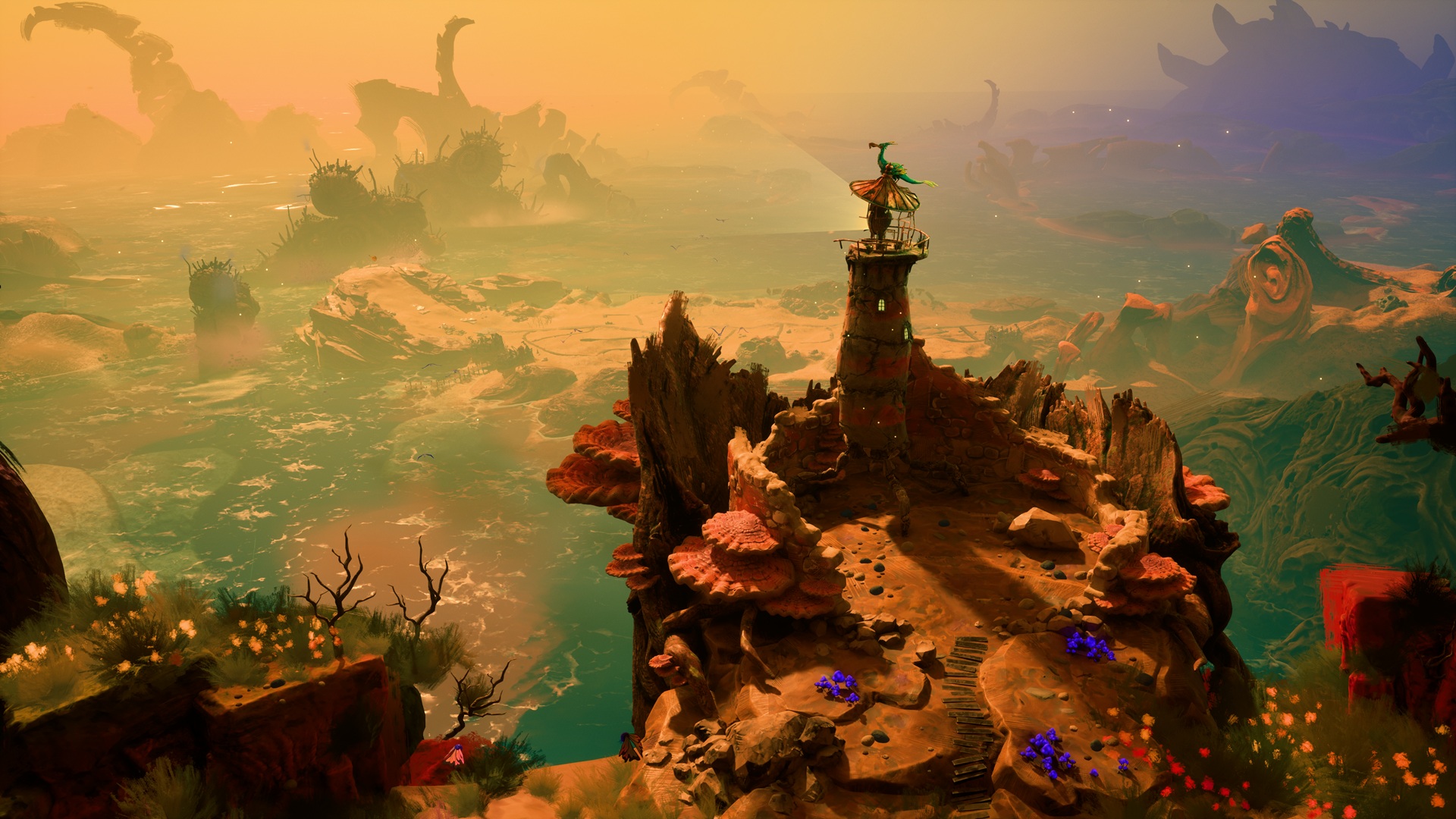Storybook fables that teach grander lessons about life can come in many different forms. They can be stories about humans. They can be stories about animals with human qualities. They can be tales of friendship, maybe between humans or talking animals. It’s not often, however, that you encounter a poignant yarn about a lighthouse and a bird.
The premise of **Keeper**, the latest puzzle-filled adventure game from Double Fine, suggests an oddball, almost wacky, kind of friendship story. Yet, it ends up being a grander tale about life, time, and nature—one that harbors a surprising amount of emotional depth for a story about a lighthouse.
### Turn on the Light
It can sometimes be difficult to convey what makes a game like Keeper such a grand adventure without dipping into at least some light spoilers. While I’ll try to keep things as vague as possible, it’s not always easy to avoid discussing later parts of the story in more detail. Please keep that in mind as this review progresses.
Keeper’s story takes place in a distant future where humans have long since died out. A remote island is threatened by a dark force known as the Wither. A lighthouse suddenly topples over after years of inactivity—the ages having worn out its foundation. However, it sprouts a pair of legs and begins walking about, seemingly coming to life.
As the lighthouse moves, a curious bird named Twig flies by and decides to nest atop its peak. The lighthouse can only move forward, and as time passes, Twig helps it on its journey, having developed a strange bond with this seemingly inanimate companion.
A story like Keeper’s easily could have fallen apart if it leaned too heavily on exposition. There could have been a full-blown cutscene explaining what the Wither is, how long it has existed, or the existential danger it poses. There could have been drawn-out explanations for why the lighthouse suddenly came alive or why Twig showed up when she did.
Instead, Double Fine has opted for a minimalistic storytelling approach. There’s no dialogue. The story unfolds through short cutscenes filled with simple actions and gestures. Players are encouraged to use their imagination to determine what’s happening—and more importantly, why.
### A Subtle Narrative with Deep Resonance
Keeper’s subtle narrative approach makes its story resonate all the more. The lighthouse coming alive and everything that follows can be interpreted as a metaphor for life itself.
The lighthouse undergoes several phases over the course of the game, starting with its first moments trying to adjust to its new legs. As time goes on and the story progresses, age sets in and the body slowly falls apart—but this leads to a new phase with a different purpose.
As that purpose is fulfilled, the lighthouse’s body continues to break down and transform in new ways—similar to how we humans age and change.
Without spoiling the ending, it’s a beautiful conclusion meant to inspire reflection on the nature of existence and what comes next.
Life and friendship are also beautifully conveyed through Twig. Twig begins her journey as a curious creature who saw this strange walking tower as a friend—even though it looked nothing like her. As the story goes on, Twig advances through life in her own way, eventually going through various stages alongside the lighthouse.
Again, without spoiling the ending, Twig’s conclusion is a moving one that signifies the end of a personal journey—which brings her fulfillment in an unexpected way.
### A Unique Perspective on Life and Existence
I wasn’t expecting to ponder the nature of life and existence through the view of a lighthouse’s lamp and the eyes of a weird bird. While it’s mainly the beginning and end of Keeper’s story that pose greater philosophical questions, the middle part focuses on elements of nature working together for survival.
Even without humanity, the life that remains fights to survive—to keep the world alive and thriving.
There’s a specific section prior to the game’s climax where this idea is vividly illustrated—it’s a perfect example of Keeper’s minimalistic storytelling at its finest.
### Shining a Spotlight
As part of Double Fine’s narrative approach, Keeper has no explicit objectives throughout its entire length. Sometimes, that’s for the best.
The visual beauty of this natural world and the wonder created by player actions take a big hit when there’s intrusive text. At most, objective hints will briefly pop up if you get stuck.
That said, it isn’t always easy to pinpoint which section to focus on next. During my journey, there were several moments where I wandered in circles, unable to find the next puzzle. This was especially true in a later section involving cruising the island’s waterways — going in circles for several minutes.
Keeper’s storytelling largely feeds its gameplay, making the experience all the more satisfying.
When the story begins, the lighthouse must adjust to walking on land. Like a baby taking its first steps, it moves carefully to avoid toppling. Since the lighthouse is top-heavy, players need to adjust to the physics to get around.
As the story progresses and the lighthouse takes on new forms, movement becomes easier—mirroring the transition into adulthood.
Puzzles often involve using the lighthouse’s bulb to shine light and bring life to darkened objects. Directing light at certain targets can raise platforms or open doors, clearing the way forward. The light can also stave off the Wither’s darkness—which is more a nuisance than a serious threat.
Keeper has no fail states or player deaths, so there’s no pressure to complete puzzles quickly. Nor is there a need to worry about the darkness—it only slows you down.
Twig plays a role in puzzles as well. She retrieves objects, turns cranks, or weighs down switches. The game efficiently uses a sparkling light to indicate where Twig can go, maximizing on-screen clarity and functionality.
### Clever Puzzle Mechanics and Memorable Moments
One section worth highlighting is where the lighthouse seeks to bring a dilapidated robot back to life by exploring three temples representing the past, present, and future.
In the past temple, shining the light on its symbol turns Twig into an egg, adding extra weight to pressure switches. The future temple’s symbol turns Twig into a ghost, letting her pass through walls.
Manipulating time and Twig’s temporal state is one of Keeper’s cleverest puzzle ideas—and it ends far too quickly. I would have loved to see more of this intriguing concept.
Another memorable section, arriving near the story’s climax, shifts Keeper from a walking simulator to an intense, fast-paced Marble Madness-style wild ride down tunnels. Here, players must use momentum to solve puzzles and clear areas.
It’s a total blast, and the perfect lead-in to the story’s powerful ending.
### Captivating Settings and Cinematic Camera Work
Double Fine makes the most of Keeper’s settings, encouraging players to soak in the world’s beauty at all times.
This is partly why there’s no dedicated camera control. Instead, the camera is used to great effect when entering new areas—often featuring cinematic corner shots, bird’s-eye views, and perspectives from underneath the landscape.
The result is a gorgeous, natural world enhanced by thoughtful camera placement.
However, the lack of camera control isn’t always ideal. Sometimes, being unable to move the camera can add unnecessary challenges to certain puzzles.
### Friendship Takes New Forms
Keeper is a beautiful story of life and friendship. It’s the kind of tale that could easily translate to an animated feature and still feel powerful.
But it’s at its best when paired with the puzzle design and narrative pacing only a video game can deliver.
Double Fine is known for delivering varied gaming experiences, and Keeper stands on its own as something entirely unique.
If you’re in the mood to contemplate the nature of the universe, Keeper is a story worth checking out.
It’s hard to imagine a living lighthouse stirring such emotions, but that’s exactly what makes this game a true Keeper.
https://www.shacknews.com/article/146369/keeper-review-score




